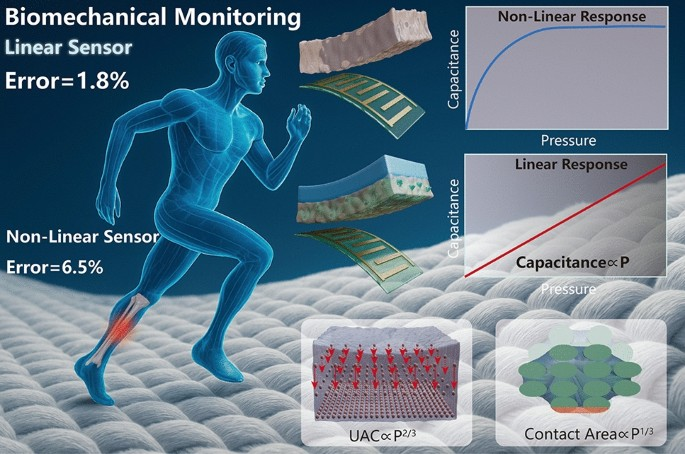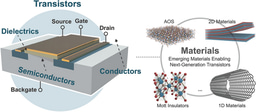Skin-Inspired Ultra-Linear Flexible Iontronic Pressure Sensors for Wearable Musculoskeletal Monitoring
Published in Bioengineering & Biotechnology and Materials

As wearable health monitoring advances, the demand for flexible pressure sensors that combine high sensitivity, full-range linearity, and medical-grade accuracy continues to grow. Now, researchers from the Chongqing Institute of Green and Intelligent Technology, led by Prof. Chao Zhang and Prof. Jun Yang, have developed a bioinspired dual-mechanism iontronic pressure sensor (FIPS) that mimics human skin structure—achieving record-breaking linearity and sensitivity for real-time musculoskeletal load monitoring.
Why This Sensor Matters
- Ultra-Linear Response: Maintains R2> 0.997 across 0–1 MPa, overcoming the typical trade-off between sensitivity and linearity in flexible sensors.
- Medical-Grade Accuracy: Achieves 1.8% error in ground reaction force (GRF) estimation—far superior to nonlinear sensors (6.5% error).
- Scalable & Stable: Demonstrates excellent reproducibility, long-term stability, and scalability for smart insole integration.
Innovative Design and Features
- Dual-Mechanism Sensing: Combines contact area expansion (∝P1/3) and ion concentration modulation (∝P2/3) to produce a linear capacitance-pressure response (C ∝P).
- Skin-Inspired Structure: Uses woven iontronic fabric embedded in a polyurethane matrix, mimicking the dermal collagen-elastic fiber network for wide-range mechanical adaptability.
- High LSF: Achieves a linear sensing factor (LSF) of 242,000—the highest reported to date for flexible pressure sensors.
Applications and Performance
- Smart Insole Integration: Enables real-time tibial load monitoring during walking and running on various terrains (concrete, track, lawn).
- Gait Analysis: Accurately classifies walking speeds with ~100% accuracy and predicts tibial stress with high precision.
- Durability: Withstands >10,000 loading cycles and maintains stable performance under bending, humidity, and temperature variation.
Conclusion and Outlook
This work introduces a universal design paradigm for high-performance linear flexible sensors, bridging the gap between biological inspiration and engineering precision. The FIPS platform opens new avenues for wearable biomechanics, sports medicine, and rehabilitation robotics, offering a transformative tool for early fracture-risk prediction and personalized musculoskeletal health monitoring.
Stay tuned for more innovations from Prof. Chao Zhang and Prof. Jun Yang’s team at the Chongqing Institute of Green and Intelligent Technology!
Follow the Topic
-
Nano-Micro Letters

Nano-Micro Letters is a peer-reviewed, international, interdisciplinary and open-access journal that focus on science, experiments, engineering, technologies and applications of nano- or microscale structure and system in physics, chemistry, biology, material science, and pharmacy.






Please sign in or register for FREE
If you are a registered user on Research Communities by Springer Nature, please sign in